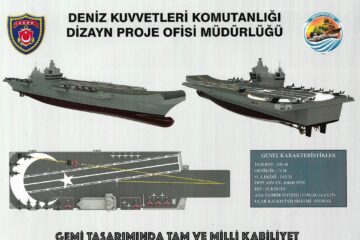Sefine Shipyard introduced all the partners of the Project during the ceremony. SEFT Ship Design will contribute to the Project by designing the vessels. Armelsan Defence will supply sonar for the NB57 USV, and Turk Loydu (Turkish Lloyd) will support the Project by developing autonomous military ship rules. In addition to its role in the automation of new vessels, Aselsan will provide gun systems (12.7 mm STAMP) to the USVs. Turkey’s missile developer company Roketsan will outfit the surface warfare drone with indigenous missile systems, just like it achieved in Turkey’s first indigenous USV Project ULAQ.
Sefine Shipyard has begun the projects in cooperation with SEFT Ship Design in September 2019. The Turkish Presidency of Defence Industries (SSB)’s information request became a milestone for the Project. The sides agreed to jointly work on constructing a multifunctional unmanned surface vessel before building the prototype. Aselsan has joined the Project in 2021, and its extensive experience in autonomous system technologies accelerated the work.
According to Aselsan’s press release, the new drones will serve in tasks such as autonomous reconnaissance & intelligence, surface warfare, anti-submarine warfare, protection of bases, ports, critical facilities, and high-value surface assets.
About Aselsan-Sefine NB57 and RD09 USV
Both vessels will be able to sail up to 40 knots. They will have an operational range of 600 nautical miles and will be on duty for four days without replenishment. The companies didn’t disclose the USVs’ size and tonnage information.
The USVs can be transported by cargo aircraft, naval ships, or land to the mission area.
Thanks to its convertibility into a trimaran with an expandable platform, the RD09’s payload capacity can be increased to carry more weapons and systems when needed. It will also be able to perform electronic warfare, ASW, and mine warfare missions.
The new vessels will feature robust automation technologies that provide adaptive navigation under the detection of the sensors onboard and will sail autonomously according to the maritime traffic rules.
In addition to Aselsan’s STAMP automatic gun on both vessels, RD09 will have two tactical missile launchers developed by Roketsan, while NB07 will be fitted with 2×2 lightweight torpedoes.
Turkey’s drone industry keeps rising:

As a result of extensive studies and investments in unmanned technologies, Turkey has become a candidate for a rising drone power worldwide. While Turkey is not a lead manufacturer of manned fighters or bomber aircraft, it has already become one of the most successful manufacturer and user of armed tactical unmanned aerial systems. It is also showing a good performance in producing related smart munitions launched from the drones.
In addition to using unmanned combat aerial vehicles (UCAV) in the real battlefield, Turkey has been integrating UCAVs into naval warfare, as Naval News reported before. Turkish naval assets and UCAVs conducted coordinated operations in the naval exercises, including neutralizing surface targets with smart munitions from the TB-2 Bayraktar drones. Meanwhile, the Aksungur medium-altitude long-endurance (MALE) UAV from Turkish Aerospace Industries (TAI) will carry out anti-submarine warfare (ASW) sonobuoy launch by the end of 2021, which is expected to extend the Turkish Navy’s ASW capabilities.
While UAV Technologies reached a significant level, ARES Shipyard and Meteksan Defence pioneered developing surface combat drones with its ULAQ USV. ULAQ has already proved itself by passing harbor, sea, and firing trials successfully; the mass production is expected to begin in the following weeks.
Although it has a long way to go, the Aselsan-Sefine duo’s NB57 and RD09 USVs will be a formidable competitor to ULAQ drone family. The competition between two USVs will enrich the Turkish drone industry, and its reflection on the Turkish Naval Forces will be positive. Because drone technologies have been evolving year after year, current naval tactics are on the edge of rearrangement according to the benefits gained from unmanned systems.
Turkey wants to develop its network-centric operations capability by using unmanned air and surface platforms together because every skill that the Turkish Navy would gain in this area will further increase its current sea power effectiveness.








